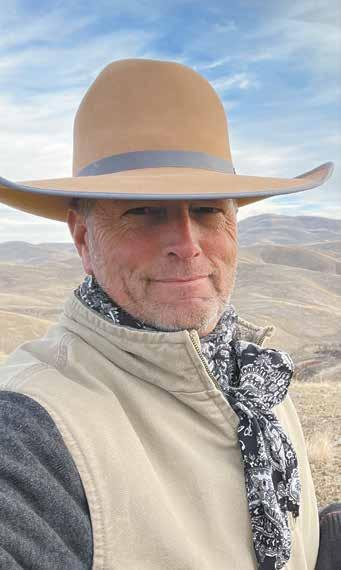Natural Resources Conservation Service U.S. DEPARTMENT OF AGRICULTURE
Contact: Heather Emmons 775-335-5146 / heather.emmons@usda.gov
USDA Invests $200,000 in Nevada to Reduce Wildlife Risk, Improve Watershed Health and Restore Wildlife Habitat in Santa Rosa-Paradise Landscape Apply for NRCS Funding by April 22 for weed treatment The Nevada Natural Resources Conservation Service (NRCS) and the U.S. Forest Service HumboldtToiyabe National Forest together will invest almost $200,000 this year to the Santa Rosa-Paradise Priority Landscape Restoration Project through the Joint Chiefs’ Landscape Restoration Partnership. The partnership enables NRCS and the Forest Service to collaborate with agricultural producers and forest landowners to invest in conservation and restoration at a big enough scale to make a difference. Working in partnership at this scale helps reduce wildlife risk, improve watershed health and restore wildlife habitat in the Santa Rosa-Paradise Landscape in Humboldt County, Nev. NRCS will provide $60,000 for three years to apply weed treatment through its Environmental Quality Incentives Program (EQIP), and producers are encouraged to apply for fiscal year 2022 funding by April 22, 2022 by contacting the Winnemucca, Nev. USDA Service Center. “The partners in Nevada are due high praise for voicing the needs and bringing resources. The Paradise Sonoma Conservation District played an important role,” said NRCS Nevada State Conservationist Ray Dotson. “We look forward to the partners assisting in the critical outreach efforts to educate local ranchers about this great opportunity. Staff from the HumboldtToiyabe National Forest are great partners. This is the second Joint Chiefs proposal approved in Nevada. I look forward to future funding based on the clear results we are achieving.”
Project partners include: the U.S. Forest Service, NRCS, the Conservation District Program, NDF, Nevada Department of Wildlife, Nevada Department of Agriculture, BLM, Bureau of Indian Affairs, the U.S. Fish and Wildlife Service (USFWS), the Ft. McDermitt Paiute and 36 APRIL 2022
Shoshone Tribe, the Paradise Sonoma Conservation District, the Paradise Valley Weed District, the University of Nevada Cooperative Extension Service Humboldt County Office, the University of Nevada, Reno’s Great Basin Fire Science Exchange and Humboldt County.
About the Landscape
The Santa Rosa-Paradise landscape is a priority landscape under Nevada Division of Forestry’s (NDF) Forest, Range and Watershed Action Plan. This landscape includes lands managed by the Humboldt-Toiyabe National Forest Santa Rosa Ranger District and adjacent private, tribal and Bureau of Land Management (BLM) lands in Humboldt County, Nevada. The collaborative funding will be used for: 1) removal of Medusahead and other invasive annual grasses and noxious weeds, and reseeding/restoration; 2) reestablishment of a cross-jurisdictional fuel break that protects the Santa Rosa-Paradise Landscape; and 3) proper functioning condition (PFC) assessments for prioritized streams to guide future watershed restoration.
The Santa Rosa-Paradise Landscape is sagebrush dominant with a diversity of other plant species in more shallow water basins. The project activities will reduce wildfire risk to multiple shared values, improve habitat for sage grouse, mule deer, Lahontan cutthroat trout and other species, and benefit the rural economy by protecting and enhancing the productivity of rangelands that support both family and corporate ranching, protecting mining industry infrastructure and maintaining and improving recreational opportunities and access and related economic activities.
the Oregon border, Orovada on the western side of the range along Hwy. 95, and Paradise Valley, all ranching communities. The Santa Rosa Range is the largest range on the western side of the priority landscape and includes the Santa Rosa Paradise Peak Wilderness. The Quinn River Valley is in the northwest, and Paradise Valley and Eden Valley are located in the south. The project area encompasses priority sage grouse habitat, including leks, Lahontan cutthroat trout streams, mule deer fawning habitat and migration corridors, cultural heritage sites, and tribal lands with culturally important plant and animal species.
“The Joint Chiefs’ Landscape Restoration Partnership is an excellent example of what we can accomplish with our partners when we manage the landscape as a whole,” said Agriculture Secretary Tom Vilsack. “Wildfires have no boundaries, and neither should our efforts to reduce wildfire risk and enhance the resilience of our forests, communities, water supplies and working lands. These Joint Chiefs projects are excellent examples of how agencies can work together and use targeted funding to achieve dramatic conservation improvements that benefit natural resources, build drought resiliency and address the climate crisis.”
Congress recently recognized the value of this important USDA program by making it permanent in the Bipartisan Infrastructure Law, signed by President Biden. This year, Forest Service and NRCS will invest in 41 projects, including 17 new projects, bringing together agricultural producers, forest landowners, and national forests and grasslands to improve forest health using available Farm Bill conservation programs and other authorities. For full project descriptions and information on completed projects, visit the Joint Chiefs’ Landscape Restoration Partnership website: https://tinyurl. com/RestorationPartnership
More Information
Agricultural producers and forest managers interested in participating in Joint Chiefs’ or other USDA conservation programs should contact their local USDA Service Center. Service Center staff continue to work with agricultural producers via phone, email and other digital tools. Because of the pandemic, some USDA Service Centers are open to limited visitors. Contact your Service Center to set up an in-person or phone appointment. More information related to USDA’s response and relief for producers can be found at www.farmers.gov/coronavirus
The Martin Fire burn area in the Santa Rosa-Paradise landscape
About the Project Area
The Santa Rosa-Paradise area is in north central Nevada along the Oregon border. Populated areas include McDermitt on The Progressive Rancher
www.progressiverancher.com


















